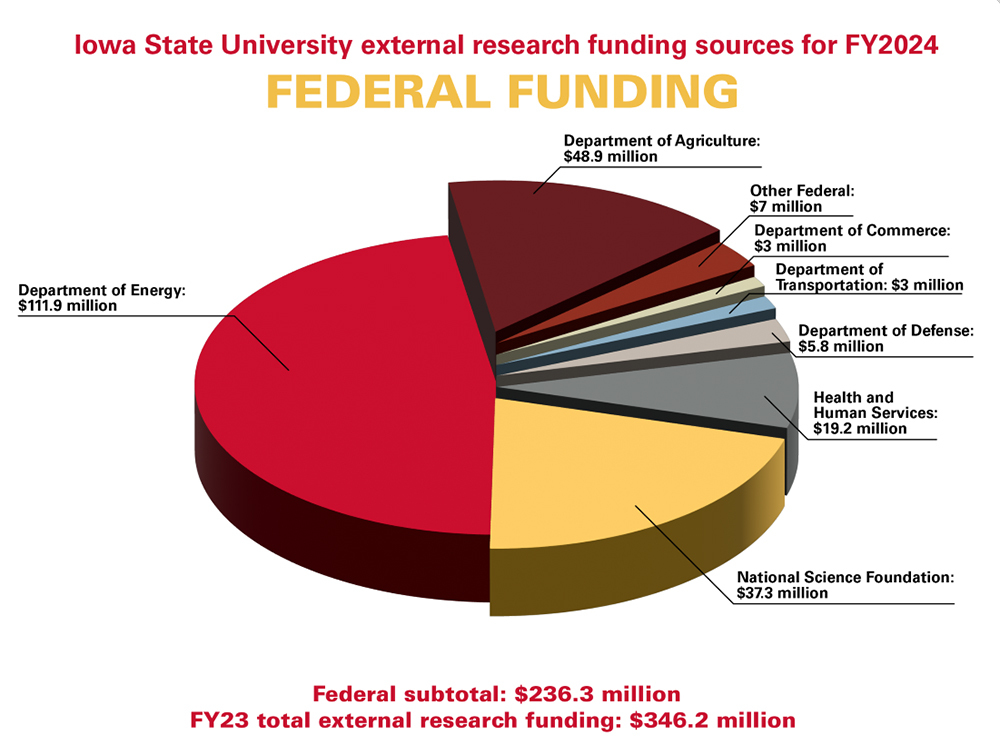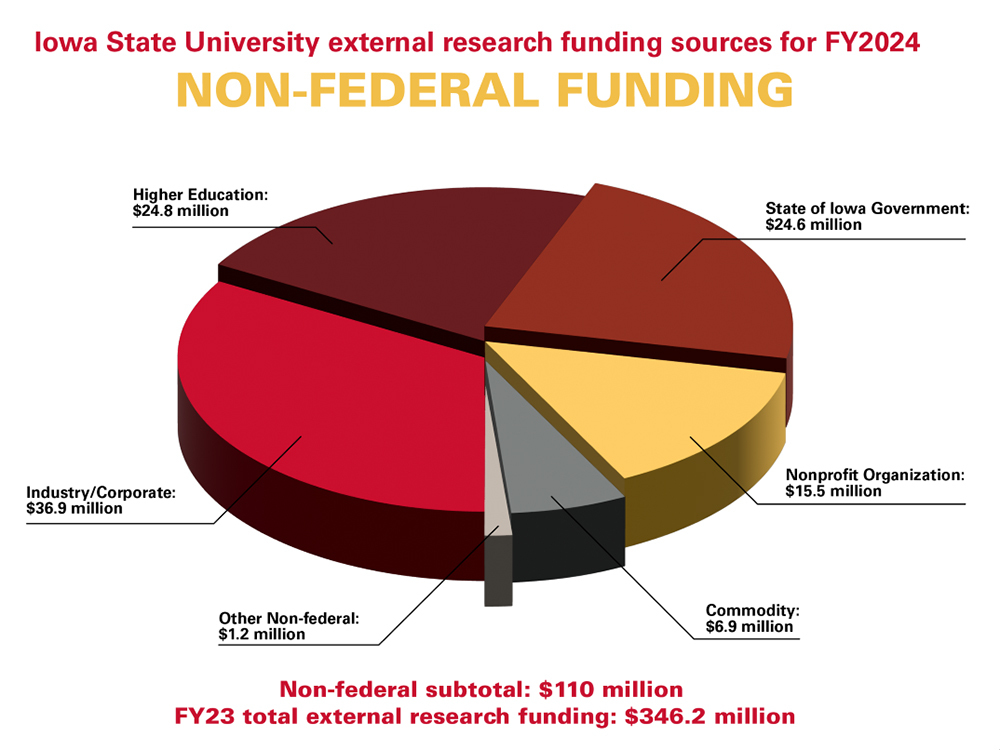Temporarily: Two-way traffic on Morrill Road
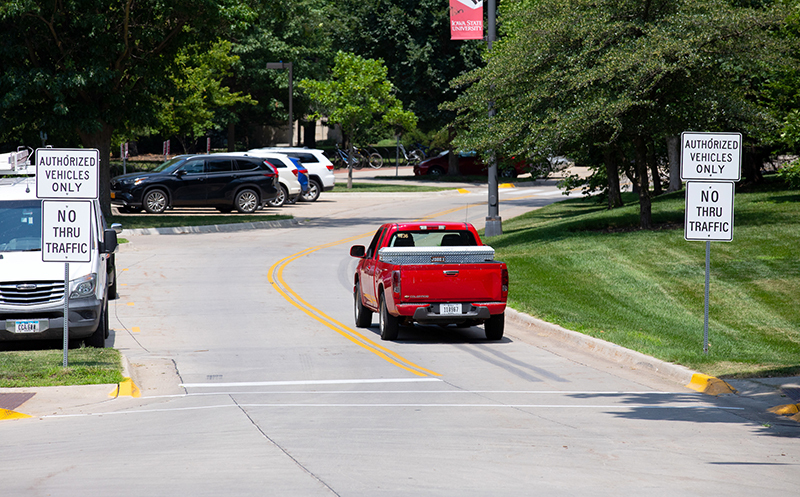
Looking north at the Morrill Road-Union Drive intersection. Photo by Christopher Gannon.
Morrill Road between Union Drive and the Hub/Morrill Hall driveway will be two-directional for about two years, or the duration of the LeBaron Hall replacement project. The road is closed adjacent to the construction site, so northbound vehicles won't be able to reach Osborn Drive.
"Authorized vehicles" generally are those with parking permits along Morrill Road and visitors or deliveries to locations such as Morrill, Beardshear and Carver halls and the Hub.
Morrill Road's westside sidewalk is open for pedestrians and bicyclists.
Parameters set for January salary increases
Performance-based salary increases have moved from July to January for faculty, professional and scientific (P&S) staff, contract staff and postdoctoral researchers, and senior leaders this week shared the parameters for those increases.
As initially shared in fall 2022, university leaders moved performance-related salary increases for all but merit employees from July 1 to Jan. 1, following a transition plan in fiscal year 2024. The shift provides additional time between external decisions on state appropriations and tuition rates and the internal decision about salary increase parameters.
For employees with satisfactory performance evaluations, the salary adjustment range is 1%-3%. For employees with extraordinary performance, up to a 4% increase is possible without additional approval. Increases above 4% require approval from the respective senior vice president or president (and the process for these requests will be shared this fall).
Employees whose performance is less than satisfactory are not eligible for a performance-based adjustment. Salary parameter details and eligibility criteria are online.
Divisions are expected to target an overall 3% increase in spending for performance-based salary increases in compliance with those parameters and eligibility criteria. Differential increases, not an across-the-board approach, is the expectation, noted vice president for university human resources Kristi Darr in her July 17 memo to the university's administrative officers.
For Ames National Laboratory employees, the university parameters may be adjusted to coincide with federal salary adjustment guidelines.
All performance-related adjustments will take effect on Jan. 1, 2025, reflecting performance reviews this fall and Dec. 31 base salaries. P&S employees with satisfactory performance evaluations and whose salaries are at, or nearly at, the maximum of their pay grade on Dec. 31 are eligible for recognition in January. Any portion of a percentage increase that's above their pay grade maximum would be as a one-time payment.
Darr included two reminders about other salary increases related to market:
- Market adjustments should be planned for prior to, or after, Jan. 1.
- Approximately 60 P&S employees whose salaries dropped below their pay grade minimum when the pay grade structure was adjusted July 1 must receive a salary adjustment by Oct. 1 to at least the new minimum in their pay grade.
Reminder: Fall performance evaluations
Performance reviews for P&S staff, contract staff and postdoctoral researchers should occur during the September through November window. All faculty performance reviews should occur during the fall semester for the previous academic year (July 1, 2023-June 30, 2024).
No time shift for merit staff reviews or salary increases
The new timelines don't impact merit staff. Performance review dates for merit staff remained the same and merit pay increases are consistent with the state's collective bargaining agreement with the American Federation of State, County and Municipal Employees, Iowa Council, and the state Board of Regents' Merit System Rules.
Per the agreement, Iowa State's approximately 1,100 merit employees received a 3% increase on July 1. As approved by the regents, merit employees not at the top of their pay grade are eligible for a performance-based increase of 1% on their anniversary date.
Five questions with our veteran provost
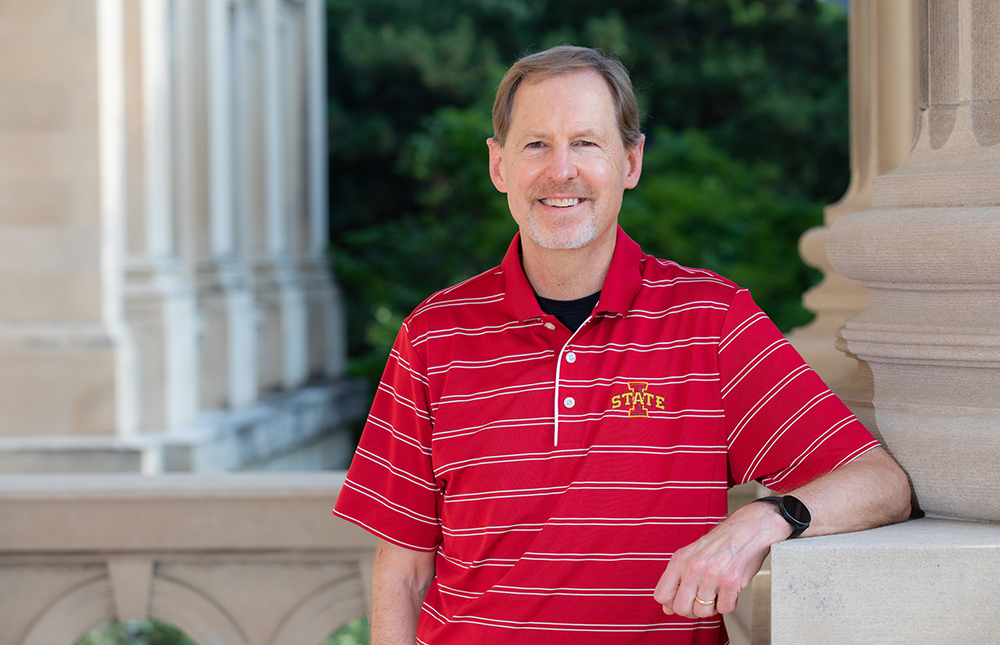
Provost Jonathan Wickert wraps up 12 years of service later this month. Photo by Christopher Gannon.
At the end of July, Jonathan Wickert will conclude 12 years of service as Iowa State's senior vice president and provost. Wickert, who arrived on campus in 2007, served as chair of the mechanical engineering department (2007-09) and dean of the Engineering college (2009-12) before becoming provost in July 2012. He served through unprecedented enrollment growth, a global pandemic and Iowa State's addition of a condensed winter session. Among many accomplishments, he hired 10 college deans and a handful of other university-level leaders. Inside inquired about his favorite days as provost and what's next for him.
You were provost for more than 4,300 days. Was there a best one?
A: Every commencement day in Hilton. About 90,000 students earned degrees from Iowa State while I've been provost. I suppose I shook about half that number of hands at commencements. Collaborating with the Faculty Senate is another highlight. Shared governance at Iowa State is alive and well, and some of my best memories are conversations with faculty senators from every department and college -- learning, sharing perspectives and developing policy.
What are your plans for the next couple of years?
A: I'll teach in Engineering and maybe a few other areas around campus. I'll work on the fifth edition of my textbook ("An Introduction to Mechanical Engineering"). My new office is in the Student Innovation Center, and I'll help students learn by doing through maker projects, just like the ones that motivated me to become an engineer. The classroom and the laboratory are where the university's real mission begins, and I'll be part of that again.
Why step down now? Why not retire as provost?
A: I think about it more as moving on, rather than stepping down. I've been provost for longer than most. I've served three presidents with different leadership styles. I'm just ready to do something else. I don't aspire to be a university president, and I'm not ready to retire yet. I'm fortunate to have helped our students at the institutional level, and now I'll make a difference at an individual level in the classroom.
You came to Iowa State as a department chair and won administrative promotions to college dean and provost. Your thoughts as you prepare to be 'simply' a faculty member?
A: Frankly, I don't think it's going to be all that simple. Although I rose up through the faculty ranks at Carnegie Mellon, both teaching and my field of engineering have changed a lot in the past 17 years. I have a lot to re-learn, and I'm sure I'll make some new mistakes. I'm hoping it'll be like riding a bicycle.
If you were to leave a note in the top desk drawer for [incoming provost] Jason Keith, what did you learn about this job that might be useful to him?
A: So, I've already written that note, and it's in that drawer, awaiting his arrival. It might be better if you asked him.
Confirm your sign-on verification factors prior to dashboard change
As announced last month, Information Technology Services (ITS) is transitioning the university's sign-on dashboard from Okta to Microsoft. Faculty and staff can anticipate a change in August to how they log in to university systems. And to get ready, they should take care of a few tasks yet this month to minimize any interruptions in the transition.
"We are shifting the sign-on dashboard and multifactor authentication (MFA) to Microsoft, which gives us security benefits and creates a more seamless environment with the university's other Microsoft applications," said Amy Ward, ITS identity services manager. She noted the university first introduced a two-step verification for the log-in process, along with the Okta dashboard, in 2017.
The Microsoft dashboard will look and function much the same as the current Okta dashboard. Employees still will go to login.iastate.edu to sign in to Iowa State apps, complete two-step verification (for example, entering a code received via text) and see a page of their available apps.
For more than a year, the identity services team has been vetting, removing and approving hundreds of apps on the Okta dashboard in preparation for the migration to Microsoft.
Update your multifactor authentication factors
In preparation for the move, employees are asked to confirm or update their verification factors in the Okta sign-on dashboard. In early August, ITS will transfer campus users' verification factors to Microsoft. Before then, all faculty and staff should:
- Ensure at least one phone number-based MFA (voice call or text) is set up, and confirm it's your current phone number.
- Confirm a secondary email address has been added to your profile information. You can't edit your username or primary email address.
Ward emphasized that not all methods can be transferred.
- Verification methods that automatically will transfer: SMS/text and voice call.
- Verification method no longer available: Okta Verify app.
- Verification method to become available: Microsoft Authenticator app.
- Verification methods available, but user will need to set up again in Microsoft: Google Authenticator, YubiKey.
In addition, any contact information employees provided for self-service password reset, including a phone number and secondary email, will be transferred.
"A significant effort has been made to prepare for this change and to make it as easy as possible for campus," Ward said. "We'll send a series of emails -- at various checkpoints -- to remind everyone of the steps they need to take and what changes to expect."
July 23: Full email needed to log in
As part of ITS' efforts to update the systems protecting users' digital identities, next week it will implement one of the more noticeable changes for users: requiring a full email address (Net-ID@iastate.edu) at sign-in, instead of Net-ID only, to provide an extra layer of protection for campus. This change will occur on Tuesday, July 23, for logins to all Iowa State services.
When Iowa State implemented Okta in 2017, Ward said the system was customized to allow users to sign in using their shorter Net-ID. With the move away from Okta, this feature will go away.
Project timeline
Most of the changes in ITS' digital identity protection project will occur in the next six weeks, with other milestones in the coming months. Ward said most of her team's work to date has occurred in the background, but starting in August, changes will be more visible to the campus community.
- Late July: all faculty and staff are encouraged to review and update their MFA methods, making sure they have either SMS text or voice call set up.
- Early August: Users' MFA factors will be transferred to the Microsoft sign-on dashboard.
- Mid-August: The Microsoft sign-on dashboard will be available to all of campus and will be the preferred MFA provider. login.iastate.edu will direct you to the Microsoft sign-on dashboard.
- This fall: Both the Microsoft and Okta sign-on dashboards will be available. The Okta dashboard should be used only as a reference to customize your Microsoft dashboard.
- Late 2024: Access to the Okta sign-on dashboard will end.
Related story:
- App scrubbing precedes sign-on dashboard move to Microsoft, June 20, 2024
Welcome
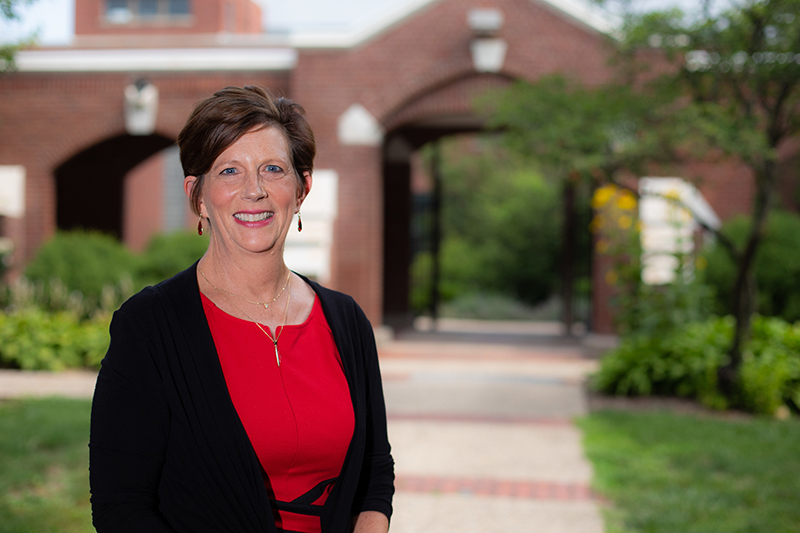
Ann Gansemer-Topf is the director of the School of Education. Photo by Christopher Gannon.
Ann Gansemer-Topf began serving this month as director of the School of Education and Frances S. and Arthur L. Wallace Professor in the College of Human Sciences.
She oversees all facets of the School of Education, which includes undergraduate programs that prepare hundreds of K-12 teachers each year, master's and Ph.D. programs that prepare leaders at all levels in the education system and high-impact research that contributes to national conversations about education and student outcomes.
Previously, Gansemer-Topf served as the school's director of graduate education. She joined the education faculty in 2012 as assistant professor, with promotions to associate professor (2018) and professor (2023). She was a faculty affiliate in the Center for Excellence in Learning and Teaching (2019-21).
She brings varied perspectives to her role from early career positions in residence life, full-time academic advising, institutional research and strategic planning.
Gansemer-Topf earned a bachelor's degree in psychology from Loras College, Dubuque; and a master's degree in professional studies/higher education and doctoral degree in educational leadership and policy studies, both from Iowa State.
Her office is in 1620 Lagomarcino. She can be reached by phone at 294-2336, by email at anngt@iastate.edu.
She succeeds Mary Gresham, who had served as interim director of the school since 2021.
Total external funding increases to a record $544.6 million
Iowa State researchers attracted a record $346.2 million in external funding for the fiscal year that ended June 30. That's the third straight year of record research funding and the second straight of more than $300 million.
Overall, Iowa State's total external funding for fiscal year 2024 increased to $544.6 million, rising $14.1 million and 2.7% over the prior fiscal year's total of $530.5 million.
"Achieving a third consecutive record for sponsored research and growth in overall external funding strengthens Iowa State University as a national research powerhouse and leading land-grant university,” said President Wendy Wintersteen. "This success is the result of our faculty and staff researchers' excellence in securing competitive funds to address complex challenges, innovate solutions for business and industry and generate economic opportunities that benefit all Iowans."
Over the 2022 to 2024 fiscal years, Iowa State researchers have attracted record external funding of $284.2 million, $301.3 million and $346.2 million to support their experiments and projects.
The latest research total also includes record amounts of federal and non-federal research funding. Those records are $236.3 million in federal support (the previous record was $206.9 million in fiscal year 2023) and $110 million in non-federal support (the previous record was $94.5 million in fiscal year 2023).
Iowa State's research leader said the records are a good measure of the value and relevance of research across campus.
"The vision for Iowa State research is to foster human creativity, fuel innovation and forge new frontiers that enable our communities, partners and stakeholders to flourish," said vice president for research Peter Dorhout. "The record research funding the university received in FY24 validates this vision. It illustrates that our sponsors value the creativity and relevance of our faculty's work, from the building blocks of basic research to translational research that yields proactive and innovative solutions to society’s greatest challenges."
External funding supports initiatives across campus, including research projects, academic support, scholarships and facility improvements. The funding can include contracts, awards and cooperative agreements from federal, state and local governments, as well as from individuals, corporations, nonprofits and other universities. While external funding supports research operating expenses, it does not support operating expenses related to the university’s educational mission.
Tornadoes, agrivoltaics, renewable natural gas and microgrids
Here are a four examples of Iowa State research projects that received external support during fiscal year 2024:
- Partha Sarkar, professor of aerospace engineering, will lead a national team that's designing and planning a center that will study windstorms and their effects on buildings and infrastructure. The goal is to engineer improvements that reduce structural damage. The National Science Foundation is supporting the effort with a four-year, $14 million grant.
- Ajay Nair, professor and chair of horticulture, is leading a multidisciplinary study of agrivoltaics, that's using solar farms to harvest energy and crops. Researchers are raising bees and growing vegetables, fruits and pollinator habitat within the 10-acre Alliant Energy Solar Farm at Iowa State University. The U.S. Department of Energy is supporting the project with a four-year, $1.8 million grant.
- Lisa Schulte Moore, professor of natural resource ecology and management, co-director of the Bioeconomy Institute and a 2021 MacArthur Fellow, is the Iowa State leader of a project encouraging more farmers to plant cover crops and perennial prairie grass. A potential incentive is demonstrating how harvested winter-hearty crops and grass can be processed into renewable natural gas. Roeslein Alternative Energy, an industry partner based in St. Louis, is supporting Iowa State's studies with an award of nearly $10.6 million.
- Manimaran Govindarasu, Anson Marston Distinguished Professor in Engineering and the Murray J. and Ruth M. Harpole Professor in Electrical and Computer Engineering, is leading the work to create a new cybersecurity center based at Iowa State that will protect wind and solar farms and local microgrids from cyberattacks. The U.S. Department of Energy is supporting the project with a two-year, $2.5 million grant.
Wintersteen recognized for statewide innovation impact
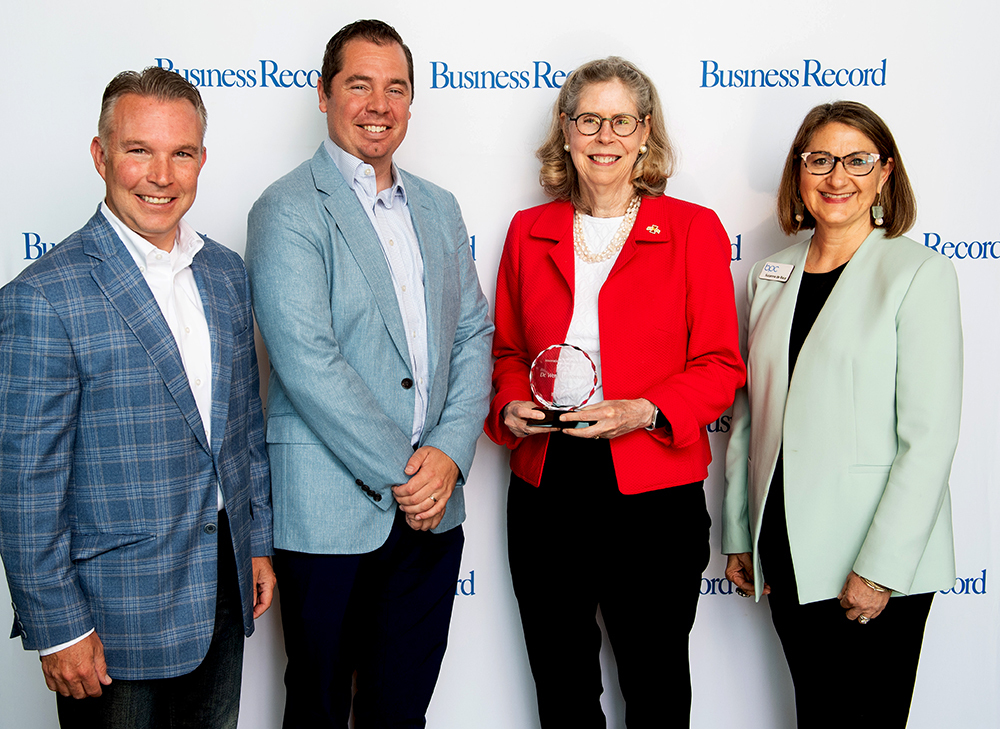
President Wendy Wintersteen received the Des Moines Business Record's innovationENTREPRENEUR of the Year award during a July 11 luncheon. Pictured with her are (l-r): Andy Lashier, president, Entrepreneurs' Organization Iowa; Chris Conetzkey, group publisher, Business Publications Corp. (publisher of the Des Moines Business Record); and Suzanna de Baca, president and CEO, Business Publications Corp. Submitted photo.
The Digital Ag Innovation Lab is one way to measure the impact of innovation at Iowa State University. Through collaboration and industry partnerships, the lab holds nearly a dozen patents and has 32 products sold globally that were developed from Iowa State research.
It also is measured by the ripple effect of $7 million in grant funding leveraged by the Center for Industrial Research and Service (CIRAS) to support advancements for small manufacturers in Iowa that generated $70 million in returns. And the 146,000-square-foot Student Innovation Center offers students a state-of-the art space for collaboration in the culinary arts, engineering, textiles and more.
These are just a few examples that illustrate why President Wendy Wintersteen was honored on July 11 as the innovationENTREPRENEUR of the Year by the Des Moines Business Record. The award, sponsored this year by EO Iowa, recognizes a leader who is known for innovative accomplishments and fostering a culture of innovation. As president, Wintersteen has made innovation and entrepreneurship a priority by encouraging a community of collaboration on campus and beyond.
"Innovation, creativity and entrepreneurship are at the heart of what we do at Iowa State University," Wintersteen said. "As part of our land-grant mission, we serve the people of Iowa with cutting-edge research and groundbreaking innovations, and by preparing graduates who are innovative thinkers."
During Wintersteen's seven years as president, Iowa State has ranked consistently in the Top 100 Worldwide Universities Granted U.S. Utility Patents, dedicated the $84 million Student Innovation Center in 2021, was named one of TIME Magazine's Best Colleges for Future Leaders, and was awarded the Entrepreneurial University of the Year for the Americas in 2023. Iowa State's research park also has seen considerable expansion during this time, growing to more than 130 high-tech companies and 2,500 employees.
The 2023 entrepreneurial university award recognized Iowa State's efforts to incorporate entrepreneurial initiatives throughout the university. This includes programs such as CYstarters and the ISU Startup Factory offered through ISU's Pappajohn Center for Entrepreneurship as well as the university's Start Something Network.
Peter Dorhout reappointed as vice president for research
Vice president for research Peter Dorhout has been appointed to a five-year second term, announced senior vice president and provost Jonathan Wickert.
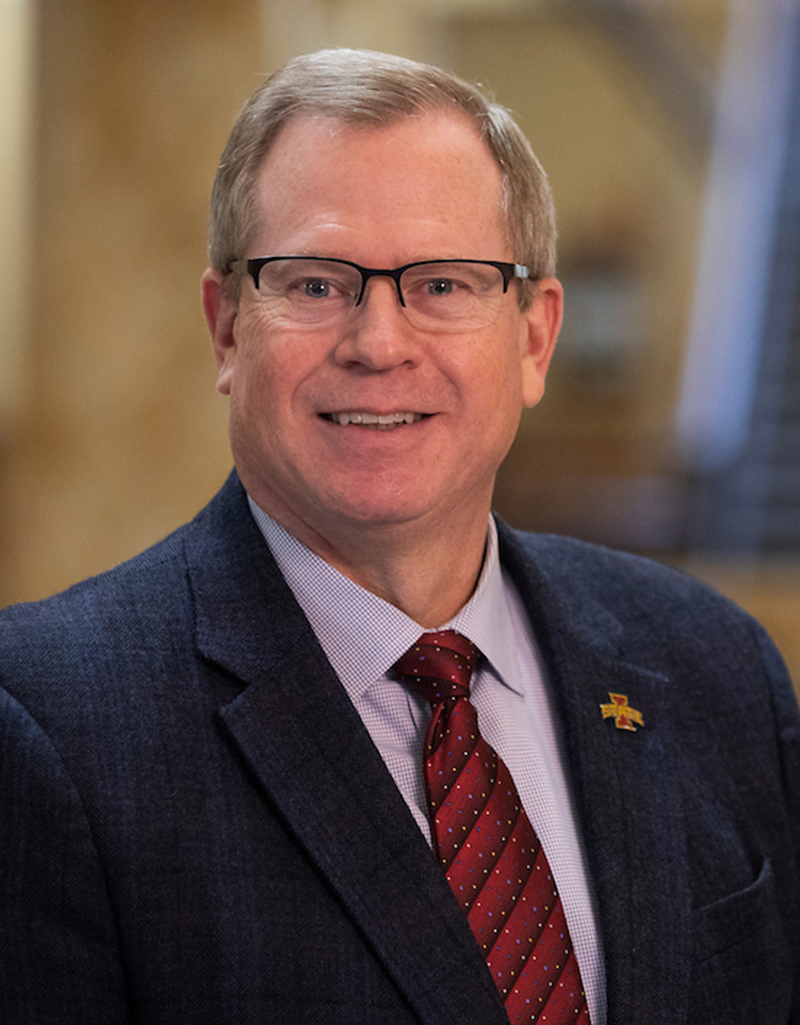
Peter Dorhout
"Peter has grown Iowa State's research portfolio, even through the pandemic, achieving record funding levels while bringing together faculty from across campus to develop innovative solutions that address our state's most pressing challenges," Wickert said.
During his first term, which began in January 2021, Dorhout has worked with faculty and staff to grow Iowa State's research programs. Accomplishments include:
- Attracting record external research funding totals of $301 million in fiscal year 2023 and $346 million in FY24.
- Fostering interdisciplinary work through a series of Research and Innovation Roundtables, which have engaged nearly 300 researchers from 70 academic departments.
- Leading and expanding three of the Iowa Economic Development Authority's four bioscience platforms focused on investing in technology transfer strategies, corporate partnerships and start-up companies.
- Growing partnerships with federal laboratories in support of research, including Ames National Laboratory, the National Laboratory for Agriculture and the Environment and the National Animal Disease Center.
- Elevating the profile of Iowa State and its research through his leadership with the national Council on Competitiveness, the University-Industry Demonstration Partnership, the American Association for the Advancement of Science and the American Chemical Society.
Dorhout also led the steering committee that produced Iowa State's 2022-31 Strategic Plan, engaging 500 faculty, staff, students, community members and external stakeholders around the plan's five strategic goals.
"It has been a great privilege to serve as Iowa State's vice president for research," Dorhout said. "Our success is made possible through the work of excellent teams -- centrally, in our centers and institutes, and in individual faculty contributions -- and I look forward to working with everyone for a second term."
An internationally renowned chemist, Dorhout earned a bachelor's degree in chemistry from the University of Illinois, Urbana-Champaign; and a Ph.D. in inorganic chemistry from the University of Wisconsin, Madison. He completed a postdoc position at Iowa State and the U.S. Department of Energy's Ames National Laboratory.
Wickert thanked the faculty and staff who participated in an electronic survey as part of the review process.
Pushetonequa gift presented to Meskwaki Nation
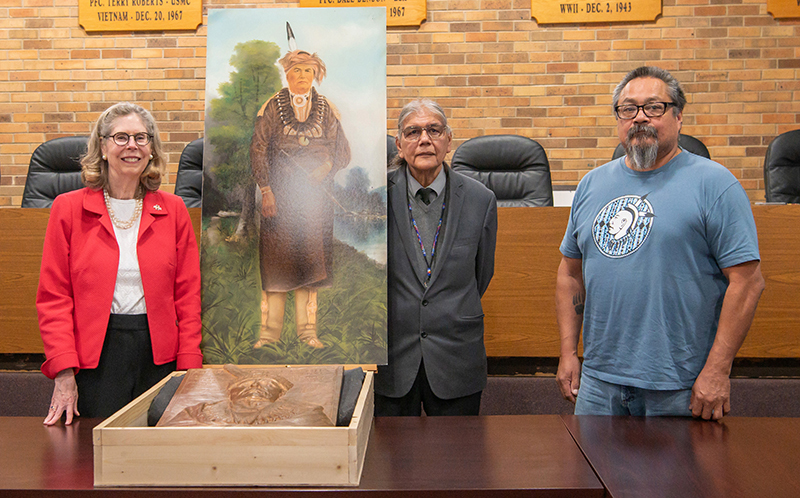
(l-r) President Wendy Wintersteen; Johnathon Buffalo, historic and cultural director for the Sac and Fox Tribes; and Leon Max Bear Jr., Meskwaki Tribal Council member, with the gifted sculpture and a painting of former tribal leader Pushetonequa. Photos by Wendy Witt, Meskwaki Media Services.
A replica casting of Christian Petersen's sculpture, Pushetonequa, will be permanently exhibited at the Meskwaki Cultural Center & Museum near Tama. President Wendy Wintersteen presented the sculpture to members of the Meskwaki Nation on July 11.
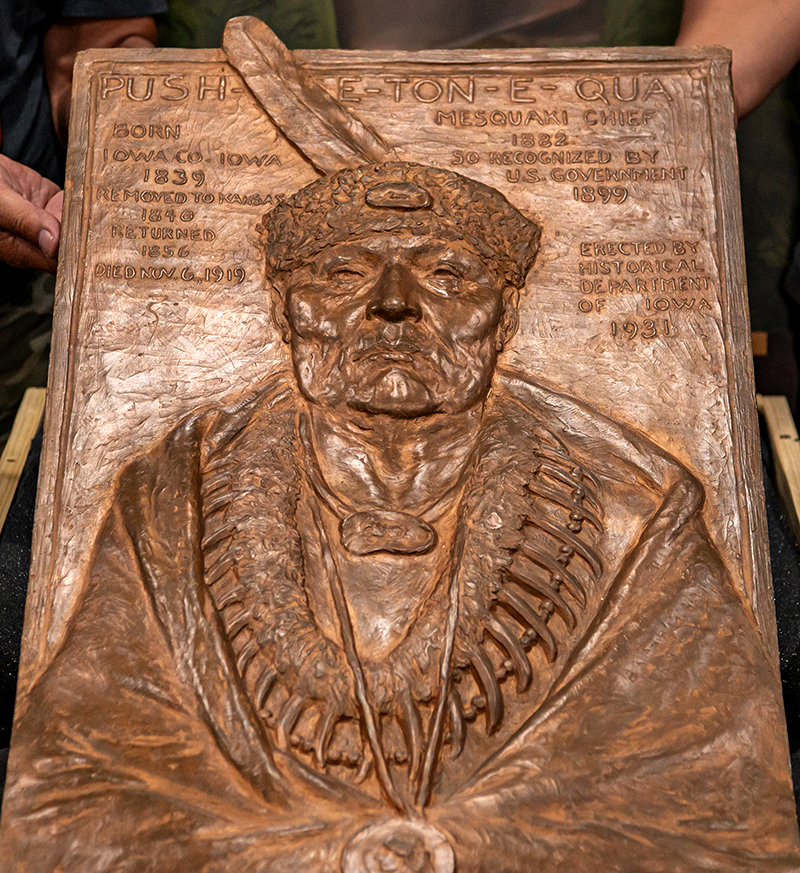
Sculpture replica presented July 11 to the Meswaki Nation.
Pushetonequa was tribal leader of the Sac and Fox Tribes in Iowa from 1882 to 1919. A replica of Petersen's bas relief sculpture was commissioned to celebrate the partnership between the Meskwaki Nation and Iowa State University Museums.
In 1929, the state's Historical, Memorial and Art Department commissioned Petersen, who later would serve as artist-in-residence and art instructor at Iowa State, to commemorate the Meskwaki chief wearing his traditional regalia. The sculpture shows Pushetonequa wearing a bear-claw necklace -- representing his status as leader -- a clamshell choker and what is believed to be a presidential peace medal.
Johnathon Buffalo, historic and cultural director for the Sac and Fox Tribes and a great-grandson of Pushetonequa, said the chief led the tribes through a time of political turmoil.
"He [Pushetonequa] did the best he could to lead us through a difficult time with faith, hope and prayer," Buffalo said. "Some tribes have not fully recovered from this period, but he led us through to be the tribe we are today."
Petersen's connections with the Meskwaki Nation continued for more than a decade. He also sculpted Pushetonequa's son, created the illustrations for a children's book, "Cha-Ki-Shi," about the Meskwaki people and drew inspiration from Meskwaki women when sculpting the four maidens for the Fountain of the Four Seasons on the Memorial Union north lawn.
The Meskwaki Nation has partnered with university museums to present exhibitions and educational opportunities dating back to 1976 and most recently, the "Artists in Iowa: The First Century" exhibition in 2019. The Pushetonequa replica honors this history and recognizes the 167 years since the Meskwaki settlement's founding and the 50th anniversary of university museums this year.
"It is our hope that this artwork honors our shared history of goodwill, collaboration and partnership," Wintersteen said. "We also hope it signals our desire to strengthen our mutual connections in education, culture and stewardship."
